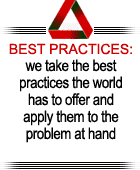



| PPJM Processes | Management Focus | |
| Initiate | The business rationale, scope, schedule and budget are defined as the baseline for the project. | |
| Plan | Prepare the detailed charter, work schedule, implementation approach and, most importantly, acceptance processes. | |
| Organize | Determine the organization, infrastructure, delivery standards, configuration management, and quality management processes. | |
| Resource | Identify and secure the people, work environment, and technological resources needed to deliver the project. | |
| Direct | Provide leadership and manage resources allocated to the project, including methods, practices and standards needed to deliver the project within the parameters outlined in the project charter. | |
| Control | Manage issues and risks and determine approaches to their resolution and mitigation. Collect information and report status of the project to the stakeholders. | |
| Close | Plan and coordinate completion of the project, the relocation of resources, and the lessons that may be used in other projects. | |
| Stages | Outcomes | |
| Visioning | Organizational directions are identified that imply a high level set of expectations
and conditions for project acceptance. Basic resources and a schedule are documented. Outcome: Project Charter & Acceptance Criteria. |
|
| Discovery | The project team determines the business requirements, organizational strengths and
weaknesses, business processes, and support systems that will serve as the foundation for project outcomes. Outcome: Business Requirements & SWOT Analysis. |
|
| Conceptualize | Based on the directional statements (where you want to be) and the SWOT analysis
(where you are today), project scope and delivery alternatives and benefits are examined to provide management with the basis to
commit to a course of action. Outcome: Alternatives Cost-Benefit Analysis. |
|
| Architect | The selected implementation alternatives are documented in detail to confirm initial
assumptions and finalize the resource requirements needed to execute the project. Outcome: Detailed Business Requirements. |
|
| Plan | The detailed business requirements are used as the basis for formulating the project
implementation plan that outlines the milestones, detailed work breakdown structure and associated resources, deliverables, and
timelines. Outcome: Project Implementation, Quality Management, and Acceptance Plans |
|
| Execute | Best practices are applied to manage the execution of the activities and tasks
outlined in the project implementation plan. Outcome: Deliverables Stakeholders Approval. |
|
| Transition | Transitioning the organization to the new state usually starts in concert with the execution stage. Outcome: Organizational Change. |
|
| Assess | The ongoing process of evaluating key performance indicators (KPIs) used by management to track progress and to ensure that the project meets evolving organizational expectations. Outcome: Management Status Reports. |
|